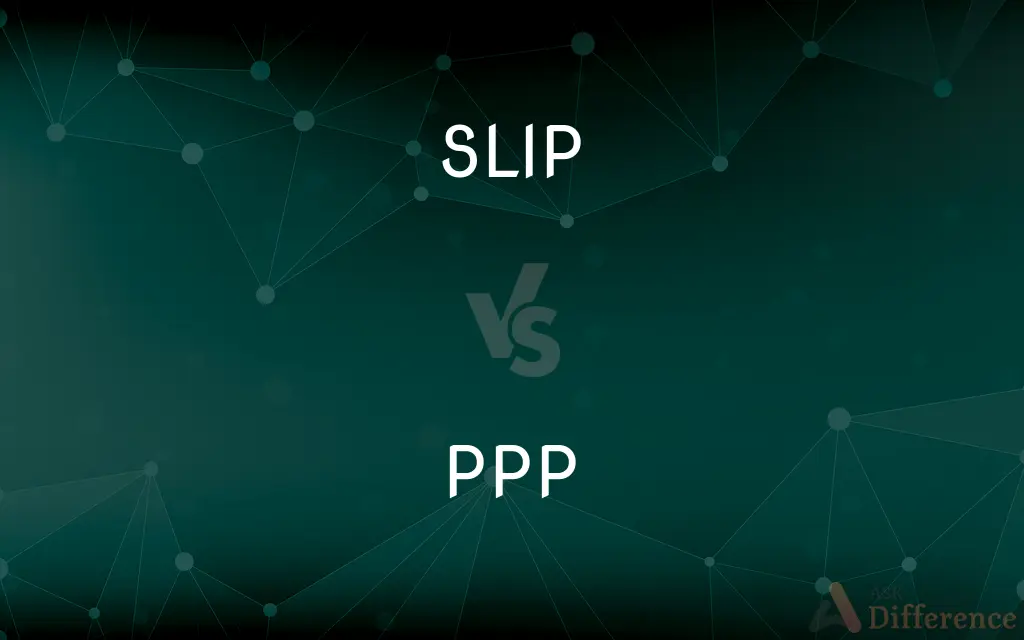SLIP vs. PPP — What's the Difference?
By Tayyaba Rehman — Published on January 17, 2024
SLIP (Serial Line Internet Protocol) is an older protocol for connecting devices over serial lines, lacking advanced features. PPP (Point-to-Point Protocol) is more sophisticated, supporting error checking and compression.

Difference Between SLIP and PPP
Table of Contents
ADVERTISEMENT
Key Differences
SLIP, or Serial Line Internet Protocol, is an early standard used for connecting computers through serial interfaces. It is basic, providing minimal control mechanisms. PPP (Point-to-Point Protocol), on the other hand, is a more advanced protocol designed for the same purpose but with additional features like error detection and correction.
SLIP is known for its simplicity and ease of implementation, making it suitable for basic applications. It encapsulates datagrams for transmission but lacks features like authentication. PPP provides a more secure connection with features like link quality monitoring, multilink, and authentication protocols, making it more reliable for current applications.
In SLIP, there is no distinction between network protocols, and it cannot differentiate between them. It simply sends IP packets. PPP, however, can encapsulate multiple network layer protocols and manage them effectively, providing a more versatile connection.
SLIP does not support error detection or automatic configuration, leading to more manual setup and potential for errors. PPP includes error detection and can configure connections automatically, making it more efficient and less prone to configuration errors.
SLIP is largely obsolete in modern networking due to its limitations and lack of support for modern networking features. PPP remains relevant, particularly in scenarios like VPN connections and direct links between two network nodes, due to its robustness and versatility.
ADVERTISEMENT
Comparison Chart
Complexity
Basic protocol, minimal features
Advanced protocol, with extensive features
Error Detection
Lacks error detection and correction
Includes error detection and correction
Network Protocol Support
Only supports IP
Supports multiple protocols
Authentication
No authentication mechanism
Supports authentication
Usage
Suitable for simple, direct connections
Used in diverse applications, including VPN
Compare with Definitions
SLIP
Lacks advanced features like error detection.
SLIP's simplicity means it doesn't handle errors well.
PPP
A protocol offering secure, reliable point-to-point connections.
PPP ensures a secure connection between these two nodes.
SLIP
Primarily used in older, basic networking setups.
This old network relies on SLIP for serial communications.
PPP
Includes features like authentication and compression.
PPP's compression feature optimizes data transmission.
SLIP
A predecessor to more complex protocols like PPP.
SLIP was an early stepping stone before PPP development.
PPP
Common in applications like VPN and direct internet connections.
This VPN utilizes PPP for establishing its secure connection.
SLIP
A protocol for simple serial communication.
Configuring a SLIP connection for a basic serial link.
PPP
More advanced and versatile than its predecessor, SLIP.
PPP offers more features compared to the older SLIP protocol.
SLIP
Used for encapsulating IP packets over serial lines.
SLIP encapsulates these data packets for transmission.
PPP
Supports multiple network protocols over a single link.
Using PPP to handle various network protocols simultaneously.
Common Curiosities
What are the key features of PPP?
PPP includes error correction, compression, and authentication.
Can PPP handle multiple protocols?
Yes, PPP can encapsulate and manage multiple network protocols.
What is SLIP used for?
SLIP is used for basic serial communications over networks.
Does SLIP provide error detection?
No, SLIP does not have error detection or correction capabilities.
Is SLIP still widely used?
SLIP is largely obsolete and replaced by more advanced protocols like PPP.
What is a major limitation of SLIP?
A major limitation of SLIP is its inability to support advanced networking features.
Why was SLIP replaced by PPP?
SLIP was replaced by PPP due to PPP’s advanced features and better reliability.
Is SLIP compatible with modern networking environments?
SLIP is generally not compatible with modern, complex networking environments.
Is PPP secure for data transmission?
Yes, PPP provides secure data transmission with its authentication features.
Can PPP be used for VPN connections?
Yes, PPP is commonly used in VPNs for secure point-to-point connections.
What type of connections is SLIP suitable for?
SLIP is suitable for simple, direct serial connections.
Does PPP support automatic configuration?
Yes, PPP supports automatic configuration and network setup.
How does PPP handle different network protocols?
PPP encapsulates and differentiates between multiple network protocols effectively.
What makes PPP a versatile protocol?
PPP's versatility comes from its support for various network protocols and advanced features.
Can SLIP be used for internet connections?
SLIP can be used for internet connections but is limited compared to modern protocols like PPP.
Share Your Discovery

Previous Comparison
Syngas vs. Water Gas
Next Comparison
2D Shapes vs. 3D ShapesAuthor Spotlight
Written by
Tayyaba RehmanTayyaba Rehman is a distinguished writer, currently serving as a primary contributor to askdifference.com. As a researcher in semantics and etymology, Tayyaba's passion for the complexity of languages and their distinctions has found a perfect home on the platform. Tayyaba delves into the intricacies of language, distinguishing between commonly confused words and phrases, thereby providing clarity for readers worldwide.
















































